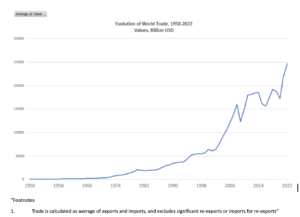Introduction
Rapid economic changes demand business leaders’ attention. Global and digital competition, along with unpredictable events like climate shifts and cybercrime, disrupt industries. The solution lies in embedding transformation as a core competency.
This “total enterprise reinvention” focuses on customer needs, adaptable talent, strategic partnerships, and ongoing refinement. A transformative culture becomes key for agile responses to unforeseen challenges and opportunities.
The accelerating pace of change in local and global economies puts the onus on business leaders to guide their companies through often choppy waters.
Increased competition is coming from all directions, firstly, from globalising organisations encroaching on native markets. The scale of this challenge is apparent in World Trade Organisation (WTO) data which reports international trade by value has “ballooned by almost 400 times from 1950 levels”. The chart shows trade growing particularly rapidly since the 1995 establishment of the WTO.

While trade growth is a good thing it can cause disruption for unprepared businesses and industries. Previously successful industries can be impacted and even decimated by smarter overseas competition. The UK auto manufacturing industry suffered badly in the late 20th century due to competition from more advanced competitors from Japan, Germany and Korea, similarly with the European computer hardware industry over the past 30 or so years. These industries were not agile enough to transform and repel the new competitive threats.
Competition has also intensified due to upstart digital-first businesses joining and disrupting traditional markets. The impact of Netflix and Amazon on established media and entertainment businesses is well known, and others such as Uber and Airbnb have heavily disrupted the travel and leisure sector more recently. Emerging Fintech and Insurtech businesses are also carving off revenues from traditional banks and insurers through niche financial services offerings delivered digitally and with a superior customer experience (CX).
As if these competitive threats were not enough, other challenges are coming from all sides. Business leaders must deal with the impacts of unpredictable events such as climate change, COVID-19, burgeoning cybercrime, geopolitical upheaval (E.g., the Ukraine invasion) and trade restrictions such as these recently imposed by the USA (E.g., The CHIPS Act), the EU and China.
As well as all these challenges, business leaders must also position their organisations to take advantage of potential opportunities. It’s a tough gig because it’s impossible to predict and prepare for all possible changes and scenarios. What’s the response?
The solution increasingly being adopted by forward-thinking organisations is to embed business transformation as a critical competency within their company. This means not just running one-off tactical transformation programs with a defined start and end date but building a strategic transformative capability into the very fabric of the business.
Plenty of organisations have delivered one-off programs, especially recently in response to challenges such as COVID-19. They must now take it to the next level by building agility and resilience throughout the whole organisation to support rapid response to future unforeseen threats and opportunities.
In a Jan 17 research report, Accenture describes moving to this new level of transformation – where the whole enterprise has agility built in – as “total enterprise reinvention”. Accenture’s research shows that while 86% of companies have done some transformation, only 8% have evolved to the more strategic next level of transformation.
Given the imperative to build a transformative culture, what do businesses need to do?
The four principles:
Embed business transformation as a fundamental competency
Business transformation capability starts at the top. The CEO and leadership team must make it part of the organisation’s mission. Leaders need business transformation strategy knowhow, an understanding of transformation methodologies, and the ability to drive through change and bring the whole business along on the journey.
Get tight with customers, learn what they want
Transformation priorities should not start from within, but with customers. Businesses must Invest and spend time to know customers better than their competitors. Deep knowledge of customer needs, extracted and mined from every customer touchpoint, helps direct transformation to address customer priorities.
Hire and retain high quality, adaptable people
Technical competence is still important in roles, but recruitment should focus on finding employees with the character, personality and skills to embrace transformation, evangelise it, and work in teams to make it happen
Create deep partnerships with transformation enablers
Since digital transformation (DX) is a core part of business transformation, businesses should supplement internal skills with expertise from partners such as cloud service providers, certified transformation and change management professionals, and firms with expertise in customer experience (CX), automation, data analytics, machine learning (ML), artificial intelligence (AI), IOT and cyber security.
Finally, businesses need to make transformation an ongoing activity, where the transformation tools, skills and methodologies built up over time are continually enhanced to produce increasingly effective outcomes.


